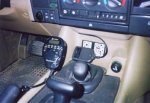Several factors contribute to CB range and clarity:
1. Antenna radiation pattern
2. Antenna's ground plane
3. Output power
4. Noise
First, you have to realize that CB is a pretty crappy medium for several reasons: It uses normally uses AM modulation, which is very susceptible to interference. When you listen to an AM broadcast, any other broadcast on or very near that frequency is picked up as well. (Unlike FM modulation) CB is also a very low frequency, making it travel well, and bounce off things well. This would be good normally, but there are thousands of CBs all around, making the noise level just that much worse. Also, as alluded to above, many people use amplifiers on their radios, which increase interference, and add their own noise into the signal. (And often widen the bandwidth of the signal, causing interference on nearby channels.
To get the most ouf of CB, I would focus more on numbers 2 & 4 on the above list. Any good fibreglass CB antenna is going to be good. Keep away from the steel whip antennas, their flapping about only makes things worse. To keep noise to a minimum, use good co-ax cable, mini-8 is good stuff, and sold everywhere. Run power to your radio either direct from your battery, or through a noise filter, or both.
Ground plane is the most often overlooked item with CB. Nearly all antennas need a good ground plane to work, including all CB antennas you find in stores. You can have a $200 antenna, but if you clip it to a bar sticking out of the side of your truck, it'll work like crap. To get the good radiation pattern you want, there needs to be a nice flat piece of sheetmetal under the antenna. The more flat, (actually 45 degrees downward is best) and the wider the better. Smack-dab in the middle of your roof would be best. The less ground plane, the less your antenna will transmit in the direction (along the ground) that you want.
For my three antennas (CB, 144/440mhz and 50mhz, I used two roof rail cross-bars to support a ground plane sheet, onto which I installed my antenna mounts. If you are OK with drilling into your roof, that would be even better. If you really must attach your antenna to a ladder or roof rack, try to get one of the false ground plane devices, which have three pieces of wire sticking out in a triangle shape under the antenna.
